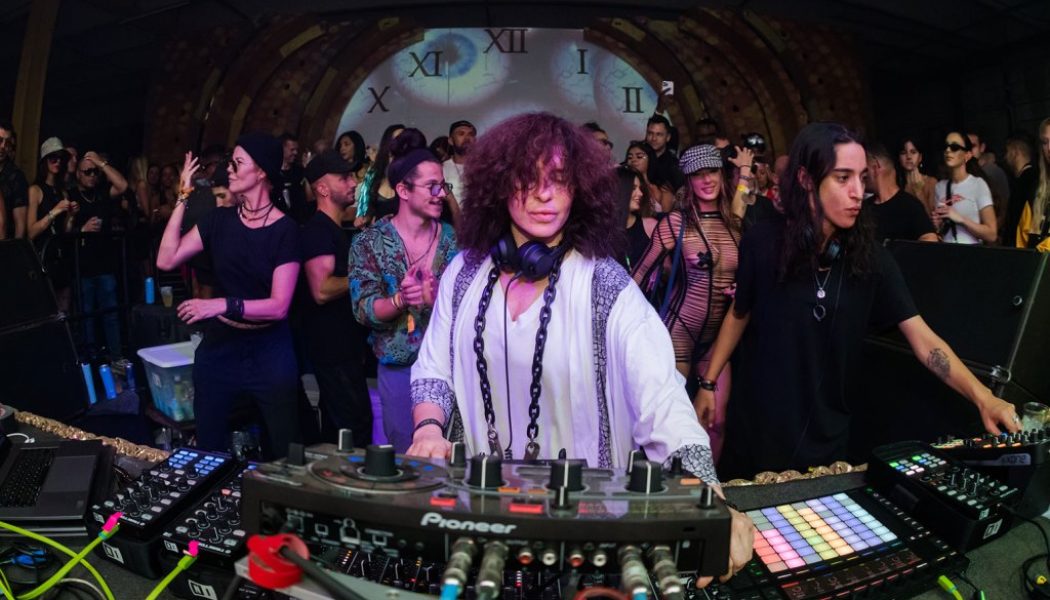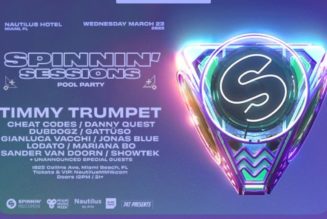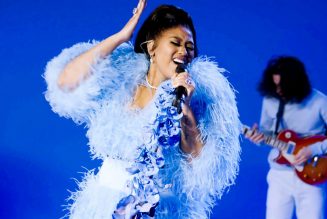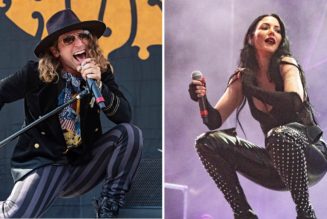The NFT | LA conference brought web3 networking into real life this week, taking over the Los Angeles Convention Center and surrounding downtown restaurants, bars and venue spaces with the city’s first-ever blockchain-focused gathering of this size.
From March 29-31, official programming at the convention center included panels and keynotes covering music, gaming, art, fashion, cryptocurrency and more intersections of culture, commerce and emerging blockchain technology. Mark Cuban, Sandbox CEO Mathieu Nouzareth, Andrew Yang and Baron Davis were some of the big names speaking, as startups showcased their new products, patrons sported shirts with their own Bored Ape characters on them and frames for displaying those virtual non fungible tokens in your IRL living room took up a considerable amount of real estate on the showroom floor.
On Tuesday, Pink Floyd saxophonist Scott Page opined on his love for business and the great potential web3 brings. This sentiment was backed by Curt Cameruci of Flosstradamus, who even brought an interactive smokable NFT along to illustrate the kind of high-minded thinking that’s going on in this space. That panel was followed by a performance by crypto punk rapper Spotty Wi-Fi, who performed onstage with virtual avatars on the screens behind him, promoting his own blockchain enthusiasm in his rhymes. Otherwise, Shara Senderoff of Raised in Space, Josh Katz of YellowHeart and Steve Aoki all spoke over the week as well, a Jim Jones performance wrapped Wednesday’s event and, on Thursday, Sir Mix-a-Lot, Macy Gray and Colton Underwood of The Bachelor spoke onstage with David Wachsman, founder of the blockchain-focused communications firm Wachsman, which helped host the event. With big ideas floating around, amid the glad-handing, the commonly heard question was, “What are you building?”
The real action, however, was at the side parties. NFT | LA played host to a number of official and non-official VIP events, including a Wednesday party for Azuki, a popular anime NFT collection launched in January by Chiru Labs; Time magazine’s TIMEPieces web3 community initiative hosted a lunch on Wednesday; a paint party (painting suit, booties and gloves provided) on Thursday hosted by FEWOCiOUS, a 19-year-old painter and NFT act repped by Andrew Gertler, Shawn Mendes’ manager; and later that night, at the James Goldstein estate in Beverly Hills — an event packed with VCs from Silicon Valley, Asia and Europe — partying and panels collided, blending margaritas with liquid nitrogen and concepts for the metaverse in areas like real estate, music festivals and fashion.
“NFT technology for music technology right now is in diapers,” said Jalen James, co-founder of World Artists United, a multimedia and entertainment agency company in New York, during one of the party’s panels. “If you get in now I promise you, move the goal posts. Billions is not the thing now. Three to five years from now we are going to be talking about trillions of dollars and we’re going to be talking about how those trillions of dollars are impacting artists globally, worldwide.”
Overwhelming throughout the week, the word “community” was thrown about as an essential element of the growing web3 scene. For music executives out networking, the confluence of NFT | LA bringing blockchain evangelicals together the week before the Grammys — taking place in a city other than L.A. or New York for the first time in decades — presented an ideal opportunity to take meetings and build relationships in this developing space, with the prospect of new business deals to follow. About one year into the web3 boom that started with eye-grabbing eight-figure NFT sales, while many in music have either been catching up or falling behind since, those executives who are actively engaging with NFTs, blockchain and the metaverse — or however you want to refer to it — are clearly setting a tone for the entire music industry’s place in web3. Whatever that winds up looking like is still unclear. But, as one major label executive said earlier this week, “If you miss NFT | LA, you have to come out for NFT | NYC.” That’ll be going on June 20-23. — Colin Stutz
Welcome (Back) to Miami
Miami Music Week was always both a marathon and a sprint— until it was immobilized.
Every March since 2011, the Magic City global dance-music industry gathering has featured a dizzying whirlwind of club sets, DJ showcases, pool parties, rooftop parties, after-hours parties, lunches, brunches, interviews by the pool and other events incorporating electronic legends, up-and-coming producers and the thousands of agents, managers, label execs, publicists, developers, CEOs, interns, promoters and fans who power the global dance music industry.
But in 2020, MMW was among the first events to succumb to the pandemic, which crippled the live events industry and the world at large in early March of that year. The hundreds of shows that make up Miami Music Week were canceled less than two weeks before the event, along with Ultra Music Festival and the Winter Music Conference, the latter a slate of industry panels and keynotes on the scene that coincides with MMW.
It was a foreboding moment in the dance world, which more than most other genres is driven by live events. While the always tech-forward dance scene dove headfirst into livestreaming, the pandemic was still crippling, with the valuation of the global electronic music industry sliding to a 10-year low in 2021.

But last week in Miami, during the first MMW since 2019, the dance world demonstrated that it’s back and once again ready to party. A nonstop swirl of soirees, music and meetings, the event showcased the new music and ventures that are pushing the scene into the future and restabilizing the industry after a period of existential challenge.
Naturally, NFTs and the metaverse were key topics, with the dance scene leading this space in the music industry since the web3 explosion in 2021. Backstage at a Friday (March 25) afternoon showcase at South Beach’s Nautilus hotel, a crew of managers swapped details about a soon-to-launch NFT DJ duo that will feature digital characters, rather than flesh and blood humans. Performances from this duo will be done in a similar fashion to the virtual concerts of Gorillaz, with the NFT group’s manager noting that while front-end costs for this project are high in terms of programming the show, overhead in terms of touring will be incredibly low.
The consensus among many MMW attendees was that the metaverse itself is a powerful marketing tool for new audiences, particularly given how closely digital spaces like Roblox resemble video games. Such streaming platforms are particularly useful in marketing dance music to young audiences who love video games, but can’t yet get into clubs and festivals, thus priming them to participate in — and spend money on — the scene once they’re older.
“The kids are choosing it for themselves, and we can meet them where they are,” Stephanie LaFera, head of electronic music at WME, told Billboard.
The crossover between electronic music and web3 was demonstrated later (like, much later) on Friday night at Miami mega-club E11even. Last December the venue purchased the #11 edition of the Bored Ape Yacht Club NFT and had the image of this Ape projected on the LED screen behind the DJ booth, where Major Lazer arrived at 3:30 a.m. on Saturday morning for a set that included remixes of tracks like the Backstreet Boys’ “I Want It That Way” and the 1989 Technotronic classic “Pump Up the Jam.” It’s unclear if patrons of the packed club were more focused on this $400,000 NFT or the vastly more IRL burlesque dancers in various states of undress on poles and platforms through the venue, which was littered with hundreds of dollar bills when the crowd began thinning around 5 a.m.
The vibe was a bit less hyphy and a lot more clothed on Thursday (March 24) during a sunset mixer hosted by Big Beat Records on the roof of South Beach’s Soho Beach House. Amongst some attendees (this one included) there had been a bit of confusion about the talent listed on the flyer, billed as “Major League DJz.”
While some anticipated a crew of marquee label stars, instead the party served up music from twin brothers Bandile and Banele Mbere, who perform as Major League DJz. Hailing from Johannesburg, South Africa, the duo delivered a genuinely captivating set of amapiano — a strain of house music exploding out of South Africa — while the sun set behind them and a crowd, including fellow South African producer Black Coffee, watched. A publicist from Big Beat reported that they’d been out with the duo the night prior during a pop-up set at Wynwood’s 100-capacity Coyo Taco that was followed by a surprise appearance from Diplo and the Major Lazer crew. (This fivesome would also show up on Saturday during Damian Lazarus’ 24-hour dance marathon Get Lost, which featured a who’s who of the dance world playing from before sunrise on Saturday to after sunrise on Sunday, by which point many attendees couldn’t accurately tell you which day it actually was.)

Also amongst this Soho Beach House crowd was an artist manager who works with a bass act out of Denver, who noted when dance events started coming back last fall, many artists and their teams were bumping into the problem of oversaturation, with too many events going on sale simultaneously and fans — particularly the younger demographic that composes a lot of the dance world’s core audience — not being able to afford them all. “It was like that for about seven months,” says the manager, “but things have leveled out again.”
Having gotten over this hump, however, he noted that artists like those he works with are still earning the same fees they were pre-pandemic, not having had the opportunity to level up over the past few years and making for a generation of acts whose earning potential was at least temporarily stalled.
Happening earlier in the day on Friday at the Standard Hotel was a Womxn in Dance Music Miami Brunch hosted by Meta Music Partnerships in partnership with She Is The Music and SheSaidSo. Here, female and female-identifying artists, managers, execs and agents (along with a few dudes) mingled over champagne while discussing dance music’s standing within the greater music industry.
“The industry is bigger than it’s ever been,” noted LaFera, citing a statistic that dance music composes 34% of all festival programming in the United States. “It’s just that the scene has diversified again [after the EDM explosion], so people can’t point to a top 10 highest-paid DJ list anymore. The dance space is wider than that, which is not as interesting to the wider industry.
“But the less attention we get,” LaFera added, “the better the music is.”

Indeed, while dance music has perhaps become less interesting to the industry at large in the post-EDM era, Ultra Music Festival demonstrated the continued popularity, viability and excellence of the music. Taking place March 25-27, the 55,000 person-per-day gathering serves as a sort of pyro-blasting exclamation point to MMW. This year’s lineup featured stars including Hardwell, Carl Cox, Alison Wonderland, David Guetta and a flurry of other genre-spanning acts.
This year, Ultra returned to its original home at downtown Miami’s Bayfront Park after a fairly disastrous move to Miami’s Virginia Key in 2019. Industry folks mingled on the massive yacht that serves as a backstage hangout area, where an individual close to the fest noted that, with Miami police declaring a state of emergency in South Beach the week before after a pair of shootings during spring break, law enforcement was less focused on Ultra over the weekend. That said, the festival didn’t seem to even warrant the attention, with local police reporting just 18 arrests over three days, according to CBS Miami.
Ultra was also sold out, which one longstanding music publicist said was in line with much of what he’s currently seeing in ticket sales. “Dance shows are selling really well right now,” this publicist told Billboard. “Ticket prices in other genres are going up; in dance they’ve stayed the same, since a lot of clubs can profit through bottle service.”
Prior to MMW 2022, it was unclear whether things would feel the same in Miami this year. Arguably, in this period of reemergence, reconnection and reinvigoration, they felt better.
Certainly, dance music isn’t the most recognized genre in the global music industry, trailing hip-hop, Latin and pop in terms of visibility and streaming; many dance music professionals proudly call it the industry’s “bastard child.” But MMW 2022 proved that the dance industry remains strong, and that after a quiet few years, a huge amount of artistry, energy, enthusiasm and earning potential is pushing this space into the future. – Katie Bain
[flexi-common-toolbar] [flexi-form class=”flexi_form_style” title=”Submit to Flexi” name=”my_form” ajax=”true”][flexi-form-tag type=”post_title” class=”fl-input” title=”Title” value=”” required=”true”][flexi-form-tag type=”category” title=”Select category”][flexi-form-tag type=”tag” title=”Insert tag”][flexi-form-tag type=”article” class=”fl-textarea” title=”Description” ][flexi-form-tag type=”file” title=”Select file” required=”true”][flexi-form-tag type=”submit” name=”submit” value=”Submit Now”] [/flexi-form]









Tagged: business, Business news, Dance, entertainment blog, Inside Track, Metaverse, Miami Music Week, music blog, NFT LA, NFTs, Tech, web3